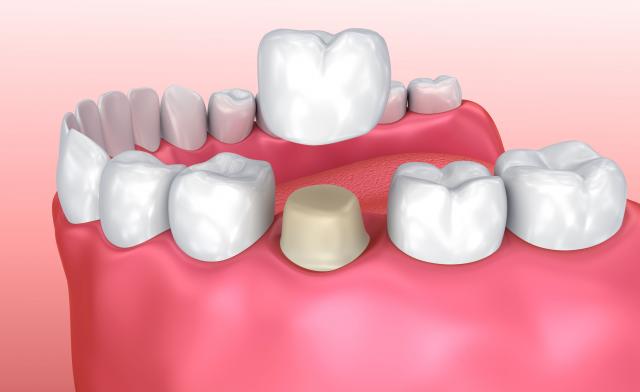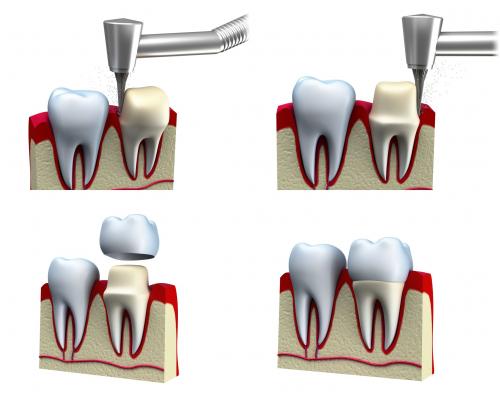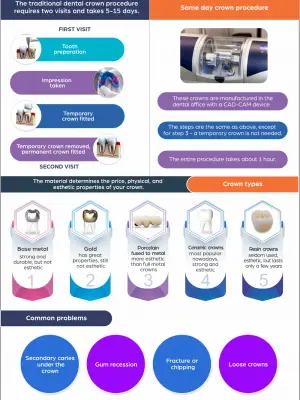Our dental crowns infographic shows the most important information about crowns:
- What is a dental crown?
- When do you need a crown?
- Steps of the procedure
- Most often used materials
- Common problems
When is a dental crown needed?
There are a number of conditions when crowning may be required. Some of them are:
Weak tooth
After root canal treatment
Your tooth has two layers: enamel and dentin, next to dentin is the pulp which is the vital tissue of your tooth. If the pulp is functioning well, your tooth is alive. If your pulp is damaged due to a sudden blow such as an accident, your tooth becomes non-vital / dead.
A dead tooth is weak and can fracture easily. In such cases, a crown comes to your help. It makes sure your tooth stands as strong as it was before. Your dentist performs a root canal treatment (RCT) for the dead tooth and places a crown on the tooth.
In case of structural defects of tooth
Certain diseases such as amelogenesis imperfecta and dentinogenesis imperfecta make your supporting layers of enamel and dentin weak. In such cases, crowns are of help.
After large fillings
If the filling is large, it can weaken the tooth as there’s little tooth structure remaining. In such cases, it can easily fracture but a crown can save your tooth.
Broken tooth
Though the broken part of your tooth can be re-done with a filling, it may not stand for long. In such cases, crowns make sure your teeth are as good as before.
Missing teeth
A dental crown helps you replace your missing teeth with a bridge or an implant.
A bridge is a prosthetic device that bridges the gap between two teeth. For placing a bridge, your dentist prepares the adjacent tooth so as to hold the bridge. Usually, a bridge has at least two crowns. Your dentist fixes them to your adjacent teeth which act as a support. The supporting teeth are also known as abutments and the artificial tooth that you are replacing is known as a pontic.
Crowns also help implant-supported bridges. The implant is an artificial tooth root made of titanium or zirconia, feels just like your natural tooth. Your oral surgeon places it into your jaws via a surgical procedure. Once it heals with the jawbone and the implant is well seated, your dentist places a crown or a bridge.
In an implant-supported bridge, an implant is on one side and the abutment is on the other side. The abutment also needs a crown.
Misshaped teeth
Some teeth may not have an ideal shape since birth. Crowns help such teeth look normal.
Heavily stained teeth
In some instances, teeth are so heavily stained that your dentist cannot completely whiten them, for instance, fluorosis. Fluorosis is a condition where there is excess fluoride in water which causes undue stains on your teeth. A dental crown helps you mask those stains.
Excessive decay
Sometimes kids’ teeth are highly prone to cavities. In such cases, crowns help to protect your child’s teeth.
For the perfect smile
Sometimes you may want to better your smile. Dental crowns can help you with the shape and shade of teeth that you want.
A short video about the entire dental crown procedure. This is how a traditional dental crown treatment looks like. Duration: 2:15
The dental crown procedure
These are the common steps of a traditional dental crown procedure:
1. Examination
Your dentist first analyses the tooth that needs a crown, the purpose for which you are opting for a crown, and decides the process and type of crown to use.
Your dentist also examines your other teeth especially the adjacent and opposing teeth, whether they need any treatment such as fillings or deep scaling/cleaning. These factors decide the success of your crown. If all the adjacent and opposing tissues are in optimal health, your crown can last longer.
The dentist will take some X-rays of the tooth that is going to receive the treatment. In case the damage is too significant, then a root canal treatment might be needed.
2. First part of the treatment
Your dentist anesthetizes the area for which you will be receiving a crown.
Then, your dentist files your tooth so that it fits the crown well, and this process is known as tooth preparation. If you are going to have a bridge, your dentist will also prepare the adjacent teeth.
Sometimes you need a crown for an implant-supported bridge. In such cases, your bridge may have the support of an implant on one or more sides of the bridge.
Then your dentist takes an impression of all the prepared teeth.
Your dentist will help you to choose a crown shade that perfectly matches your natural teeth.
Your doctor may give you a temporary crown to protect your teeth till your final crown is ready.
3. The lab work
Once the impression is taken and you've chosen the shade and material of the crown, your dentist sends the impression to the lab.
It can take anywhere between a few days and a few weeks for your crown to be ready. Some labs are faster, others are busier.
It's also a good idea to ask the dentist where the dental lab is located. It's best to use a local lab, crowns shipped from overseas might be more affordable, but their quality can be suboptimal and because of the shipping it'll take longer to receive your permanent crown.
4. Second part of the treatment
Once your permanent crown is ready, you need to have a second appointment with the dentist.
Your dentist checks the fitting of your crown, makes necessary adjustments, and fixes the crown onto your teeth with a cement / dental glue.
The dental glue is made of powdered glass or synthetic resin and it cements via resistance, retention, or chemical bond.
If, for whatever reason, the crown doesn't feel or look right, make sure you let the dentist know before cementing it. In this case, the dentist might send back the crown to the lab for adjustments.
This is how the process of crowning looks like. Some problems may develop after the crown is cemented like allergic reactions, discomfort, sensitivity, chipping off, loosening, falling off, cracking, etc.
Generally, a crowned tooth does not require any special care regimen but it also does not ensure complete protection to the underlying tooth from gum disease and infections. Thus, brushing and flossing must be done regularly.
A short video about the entire dental crown procedure. Duration: 2:54.
Same day crowns
Same-day dental crowns are relatively new and still developing technology in dentistry.
Single sitting crowns are made of ceramic. The dentist uses CAD (Computer-Aided Designing) / CAM (Computer-Aided Manufacturing) technology to manufacture the crown in the dental office.
These are the steps of the same day crown procedure:
- filing your tooth
- your dentist uses a special intra-oral camera to take several images of the prepared tooth
- with the help of these images, your dentist designs a new crown in the computer
- the dentist does all the fine adjustments for the crown in the computer itself
- the milling machine at your dentist’s office carves a new crown out of ceramic
- once the crown is ready, your dentist glues the new crown on to your tooth
As you can see, there is no need to take an impression, wait for the lab, or get a temporary crown. Also no need for a second appointment.
Same-day crowns are usually somewhat cheaper than a traditional crown, they are as durable as lab-made ceramic crowns, however, they are usually somewhat less aesthetic than lab fabricated crowns.
It's also good to know that not all dentists have such CAD-CAM devices in their lab and especially not many of them are really experienced with this procedure.
Once a damaged, decayed or root canal treated tooth is prepared, a crown is placed to cover and support the tooth.

Various types of dental crown materials
There are a number of different types of dental crowns to choose from. All have their own advantages and disadvantages:
Full metal crowns
As the name suggests, they are crowns made of metal. They can also be a combination of various metals which are known as alloys.
Advantages:
- They are stronger and are suited for back teeth. They are tough enough to withstand the chewing forces.
- They do not wear out the opposing teeth.
- They last much longer.
- They provide a stronger seal around your tooth.
Disadvantages:
- They have a metallic look.
There are several types of full metal crowns.
- Gold crown: It is a combination of gold, copper, and other metals. Captek crown is a new and high-quality version of gold crowns.
- Base metal alloy crown: They can be a combination of nickel-chromium or cobalt chromium. They require the least amount of tooth to be removed while preparing your tooth for the crown.
- Stainless steel crowns: They are also known as prefabricated crowns. After a root canal treatment, they protect your prepared tooth till your permanent crown is ready. They are also useful in children to protect a decayed tooth that needs a crown. As these are prefabricated, your child can skip the multiple visits for a crown.
Ceramic crowns
They are also known as porcelain or all-ceramic crowns. They are made of porcelain.
Advantages:
- They are suited for the front teeth, as they look just like your natural teeth.
- They are an ideal choice for people with metal allergies.
Disadvantages:
- When you use a porcelain crown, the seal around your tooth depends on the strength of your tooth as well as the kind of filling.
- Their strength is questionable especially if someone has the habit of grinding teeth at night.
There are several types of full ceramic crowns:
- Zirconia crowns are the most durable and natural-looking type of teeth crowns. Their only disadvantage is their higher price.
- Emax crowns are probably the most aesthetic type of crowns. They are getting more and more popular for restoring front teeth.
- Lava crown is another newer type of all-ceramic crown. Preferred for front tooth restorations.
- CEREC crown - unlike most other crowns, this crown only requires one visit to the dentist.
Resin crowns
Advantages:
- Resin crowns look like your tooth and suitable for front teeth.
- They are economical.
Disadvantages:
- They are weaker and can fracture easily.
Porcelain fused to metal
PFM crowns have a metal lining inside and porcelain on top of it.
Advantages:
- They are stronger and last longer
- The metal surface bonds better with tooth
Disadvantages:
- They look opaque, thus may not perfectly match your natural teeth.
- The metal line at the interface of porcelain and metal may be visible at the gum line. This is truer when gums have receded/ go down towards the base of the tooth.
A video about the different types of dental crowns. Duration: 3:29
How long does your dental crown last?
On average, a crown lasts for seven years. However, if you maintain them well, they can last for a lifetime.
7 tips to make sure your dental crown lasts longer:
1. Brush twice a day.
2. Floss every day.
3. Avoid grinding your teeth/ biting nails/ opening packages with your tooth.
4. Use a good quality toothbrush, paste, and floss. Though your crown protects your tooth, you have to protect your tooth near your gums. Your dentist may give you a high fluoride gel to protect your tooth against gum infections.
5. Meet your dentist if you face any issues with your tooth/crown/filling:
- Sometimes your crown is over a living tooth (that is not root canal treated or not an implant). In such cases, if you experience pain or sensitivity when you bite down, talk to your dentist. The dentist will do the required adjustments.
- Sometimes dental crowns can become loose. If you feel the crown is not fitting well, talk to your dentist. An ill-fitting crown may invite decay.
- After some use, the crown may fall. If it does, keep your crown safe and bring it to your dentist. Your dentist will do a thorough examination and if it’s suitable, the crown might be recemented. In situations where you have to replace the crown yourself, clean the crown thoroughly of any debris or remaining cement. Use a wet cotton swab to do the final cleaning. Cement the crown using a temporary cement or denture adhesive. Schedule an appointment with your dentist at the earliest.
6. Schedule a regular dental check-up every six months.
7. If you are having a temporary crown, avoid sticky or hard foods. Avoid chewing from that side.
The typical steps of a dental crown procedure.

How much does a dental crown cost?
The typical cost of a dental crown can be anywhere between $800 and $2,500.
It's rare to see prices below $800 (depends on the crown, resin crowns are more affordable, but they don't last long).
Prices over $2,500 are not uncommon, there are many factors that could raise the cost of your treatment.
These are the main factors that affect the cost of a dental crown:
- crown size and material
- dentist's experience and location
- additional treatments required (a dental implant or a root canal treatment can raise the final price to $3,000 - $5,000 for a single tooth)
- number of crowns required
- insurance or dental plan coverage
As you can see, the price of a crown varies from case to case, however, nowadays the usual or average price of a crown is around $1,500.
If your dentist charges significantly more and there are no additional treatments needed, you might want to get a second quote from another dentist.
What’s the difference between a dental crown and a veneer?
- Veneer covers only the surface of the tooth which is visible when you smile, whereas your dental crown covers your entire tooth.
- Veneers are suitable for minor changes in color, size, shape, and alignment. For major changes in alignment orthodontic treatment is more suitable. For major changes in tooth size and shape, dental crowns are more suitable.
- Veneer needs less tooth preparation than a crown. Sometimes there may not be any need for tooth preparation for placing veneers.
- Veneers are around 1mm in width whereas dental crowns are around 2 mm in width.
Partial crowns or onlays are somewhere between veneers and full crowns, as they don't cover the entire tooth but cover more than the visible surface.
Differences between crowns and veneers. Duration: 2:50.
Can a dental crown be removed?
There are a number of reasons why a dental crown might need to be removed. The most common ones are damaged / broken crowns, discoloration of the crown, or decay under the crown. There are several techniques for removing the crown.
Conservative approach
Here the crown is intact and suitable for reuse. Here are 5 approaches to do it.
- Resin: Your dentist softens a resin block in hot water and places it on your biting surface. Your doctor asks you to bite the resin block till it’s 2/3rd of its height. Following this, you should open your mouth rapidly. This technique is most suited for removing temporary crowns.
- Ultrasonic: Ultrasonic is another device that your dentist uses to remove the crown.
- Pneumatic (KaVo) CORONAflex: Here your dentist loops a brass wire around the crown which he/ she is going to remove. After applying the right forces in a specific direction, your crown is out. The CORONA flex crown and bridge remover uses a modification of this approach.
- Crown tractors: They grip your crown with rubber grips and gently dislodge the crown without damaging your tooth or the crown.
- Matrix bands: Your dentist may also use some metal bands known as matrix bands which fit well into the structure of the crown and pull the crown out.
Semi-conservative approach
This is more comfortable for you than the above mentioned conservative approaches. However, these approaches damage your crown to some extent, the crown is suitable for reuse after cementing the aperture.
- Wamkey: It’s a narrow-shanked cam device. Your doctor cuts a hole through the crown and exerts pressure using the wamkey to dislodge the crown.
- Metalift system: Here your dentist drills a hole on the biting surface of the crown and exerts a screwing force with a specific instrument. Due to pressure, the crown comes out. This is most suited for metal crowns.
Destructive approach
This approach is comfortable and has the least impact on your tooth and supporting structures. Here your dentist breaks the crown into parts using a bur. Following which your dentist uses an ultrasonic instrument to take off the crown/ bridge. Your doctor may also use an orthodontic plier to take off the crown.

